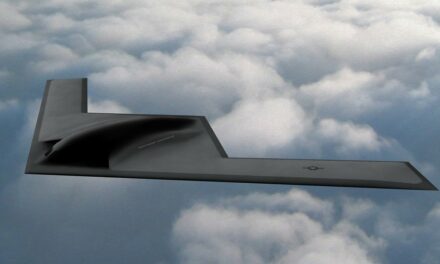We support our Publishers and Content Creators. You can view this story on their website by CLICKING HERE.
Summary and Key Points:
-The loss of a B-2 Spirit bomber due to fire and its subsequent retirement highlights the fragility of the U.S. Air Force’s bomber fleet.
-With only 19 B-2s remaining and several other bombers aging or facing retirements, America’s strategic bomber capacity is significantly reduced.
-The B-21 Raider offers hope, but budget cuts threaten its timely deployment. Ensuring the B-21 program stays on track is crucial to maintaining U.S. deterrence capabilities.
The U.S. Air Force’s Bomber Fleet Shrinks…
Our military’s strike capacity is literally going up in smoke. Just last year, a fire upon landing in a B-2 Spirit stealth bomber closed the runway at a critical air base and grounded the entire B-2 fleet for five months. Now the Pentagon has announced this B-2 is set to be permanently retired, citing that the damage was “uneconomical to repair.”
While the peacetime destruction of just one aircraft may not seem significant, it represents a sizeable chunk of the Air Force’s strategic bomber capacity. This lost stealth bomber is one of just 20 (now 19) B-2s in the U.S. Air Force inventory, making each one too significant to lose.
Of the 19 B-2s on hand, only an estimated 16 of these are considered mission-capable and ready for combat at any given moment, with the rest of the aircraft unavailable due to maintenance or testing requirements. Of those that could fight tonight, some B-2s must always be withheld from deployment to uphold the United States’ nuclear deterrent and extended deterrence commitments to treaty allies.
The many demands on an exquisite fleet of strategic assets leaves only half of America’s stealth bomber inventory ready for worldwide operations daily—making the loss of one aircraft effectively equivalent to roughly 10 percent of the mission capable B-2 fleet.
This is the definition of a fragile force, which certainly could not be expected to withstand losses on the modern battlefield and therefore lacks credibility as a serious deterrent. The decision to retire the damaged B-2 further shrinks the total US bomber mix to the smallest it’s been since the birth of the Air Force in 1947—140 aircraft—and the other bomber fleets are not faring much better.
Able to deliver a record-breaking 75,000 pounds of ordinance “anytime, anywhere”, the B-1B Lancer has long-served as the backbone of the Air Force’s strike capability. Though first introduced in 1986, recent efforts to upgrade the B-1B’s capability to launch Long Range Anti-Ship Missiles and other experimental hypersonic weapons have reinforced its usefulness in deterring peer adversaries.
However, accidents and retirements plague the aging B-1B fleet as well. Earlier this year, a B-1 crashed during a training mission, destroying the aircraft. In 2022, another B-1 caught fire and was nearly wrecked on the runway, with repairs expected to take three years to bring the aircraft back online. Both of these incidents follow the retirement of 17 B-1Bs in 2021, as the Air Force has sought to divest from the 40 year old bomber. Despite the B-1B’s powerful payload and modernization efforts, just 45 B-1Bs remain, and their full fleet retirement is expected within the decade.
The Bone isn’t even the oldest bomber in America’s arsenal; that would be the B-52 Stratofortress. Over a half-century old, the upgraded airframe is expected to remain in service until the 2050s. The B-52 actually makes up nearly half of the existing bomber fleet, standing at 58 airframes in 2023. However, its advanced age is making maintenance difficult, limiting mission availability until planned modernization is complete. Additionally, the aircraft lacks stealth capability and is less capable than its modern alternatives, limiting its mission scope.
The B-21 Raider Bomber Is Critical
There is a silver lining to America’s bomber fleet decline in the B-21 Raider. A long-time coming, the next-generation medium stealth bomber is shaping up to be a rare success story for Pentagon purchasing. Thus far, the B-21 is coming in under budget and developing in record time, setting the stage for successful production and deployment at scale.
For the B-21 to provide the force with timely strike capability and rescue the rapidly shrinking fleet, however, the program can afford no delay nor can its procurement quantity shrink. Unfortunately, under the “hard choices” of the budget caps constraining the Pentagon’s FY 2025 request, investment in key future capabilities is being sacrificed for readiness today. B-21 procurement funding would fall by nearly 30 percent from previous projections should the White House budget request be approved by Congress. Though procurement quantities are not provided, subtracting funding is hardly a recipe for success and could result in the delay of crucial deliveries, a loss of lower pricing because of bulk buying, and eventually a total tail cut.
The B-21 Raider was unveiled to the public at a ceremony December 2, 2022 in..Palmdale, Calif. Designed to operate in tomorrow’s high-end threat environment, the B-21 will play a critical role in ensuring America’s enduring airpower capability. (U.S. Air Force photo)
Washington must recognize the strategic failure of a small and antiquated bomber fleet. The Air Force was initially meant to procure 132 B-2s, but ended up buying just 21 due to the high unit cost and a supposedly-depleted need for stealthy strike capability during the war on terror. The resulting fragile fleet illustrates that the abandonment of bomber procurement was a short-sighted mistake that must be rectified if the United States is to uphold deterrence across three theaters of the world at all times.
A tiny bomber force that cannot afford losses, especially in peacetime, will not deter nor defeat America’s emboldened adversaries. As Congress considers next year’s defense budget request, they must work to ensure the B-21 stays on schedule by providing full funding to keep the program meeting cost and schedule targets. Facilitating the on-time deployment of the next generation bomber cannot come too soon in order to restore the size and strength of America’s bomber fleet.
Author Expertise and Experience: Mackenzie Eaglen
Now a 19FortyFive Contributing Editor, Mackenzie Eaglen is a senior fellow at the American Enterprise Institute (AEI), where she works on defense strategy, defense budgets, and military readiness. She is also a regular guest lecturer at universities, a member of the board of advisers of the Alexander Hamilton Society, and a member of the steering committee of the Leadership Council for Women in National Security.

 Conservative
Conservative  Search
Search Trending
Trending Current News
Current News 





